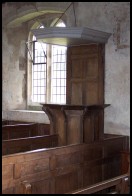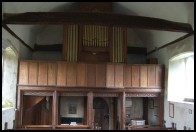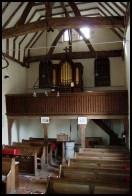| |
 
THE VILLAGE CHOIR
One of the most enjoyable programmes of
television recently, for me at any rate, was
Ashley Pharoah’s adaptation of Thomas
Hardy’s Under the Greenwood Tree. It is
Hardy’s sunniest novel, the story of three
very different men’s attempts to win the
hand of the beautiful young schoolmistress, Fancy
Day.
| But of course
there is a sub-plot, which though not
ignored, was naturally underplayed: the
passing of the old-style village choir,
who had provided the music in Mellstock
Church for centuries, and the
introduction of a new organ. This
reflected a major social and theological
change on the part of the church. Until the Reformation,
worship was largely sacramental, a
ceremony conducted in the chancel by the
priest and his acolytes, watched in awe
by the people in the nave. All this
changed in the sixteenth century, and for
three hundred years the church became a
preaching house, with the parson placed
high in his triple tiered pulpit right
among the congregation. A gallery was
built at the back of almost every church
to house a motley band of singers and
instrumentalists, who simply followed the
instructions of the parish clerk, who
announced and intoned the psalms. Hymns
were forbidden, unless they were
paraphrases of the scriptures.
|
|
 |
These musicians became
fiercely independent and often rebellious -
perhaps ten or fifteen singers, who also played a
variety of instruments, fiddles, clarinets,
cellos, bassoons and the wonderful but
hideous-sounding serpent. They were largely
self-taught and extemporised their own harmony,
but as time went by skills improved, and
Hardy’s own church at Puddletown, Dorset,
boasted no less than fifteen instrumentalists.
Music inevitably became more elaborate, and John
Foster’s arrangement of While shepherds
watched was scored for a four-part choir and full
orchestra. But far more usual were more
rumbustuous settings, like the same words to the
tune of Ilkla Moor baht’at, which caused
some raised eyebrows when we sang it in St.
Peter’s a few years ago!
 |
|
From 1830 onwards
the largely Oxbridge-educated clergy
began their long war against gallery
choirs, replacing instrumentalists with
barrel organs and harmoniums, and the
altar at the east end of the church
regained its dominant position. Surpliced
choirs were introduced in imitation of
cathedral practice, and the publication
of Hymns Ancient and Modern in 1861
effectively brought an end to the old
tradition.
What relevance has all this today? Few
west galleries remain, that in St.
Peter’s, where the great John Small
played his bass viol for an astonishing
seventy-five years, having been taken out
during Blomfield’s restoration of
1874 and East Meon’s removed five
years earlier. |
The inspiration for
Hardy’s Mellstock, Stinsford, between
Puddletown and Dorchester, lost its gallery in
1843, though a new one was built there ten years
ago.
They are still to be seen in some remote village
churches. At Corhampton, in the Meon Valley, for
example. This little Saxon church, hidden behind
a huge yew tree, and famous for its wall-painting
of St. Swithun, retains its gallery, which
ironically had an organ placed on it in 1853,
just as it has at Idsworth, though here the
gallery was actually rebuilt during
Goodhart-Rendel’s restoration of 1913.
Both churches are
tiny, and it is easy to imagine the
impact of those raucous singers and
instrumentalists, and, especially at
Idsworth, of the parson, perched high in
his pulpit, with the inscription
“Cry aloud, spare not, lift up thy
voice like a trumpet…” on the
wall close by.
Yet, rightly or wrongly, there is a
parallel between the passing of the
Mellstock choir and the present day.
During the past thirty years many
churches have lost their traditional
choir, and indeed their organ, the upkeep
of which can be prohibitive, to be
replaced by a music group, accompanied by
guitars and synthesisers, whilst
hymnbooks are sometimes jettisoned for
overhead projectors. The ghosts of Hardy
and John Betjeman must be turning in
their graves.
Tom Muckley, February 2006 |
|
 |
This article was originally
published by the
Petersfield Post
tommuckley.co.uk
|
|




